What Happened to All the Honeybees?
An unprecedent crisis threatens apiculture
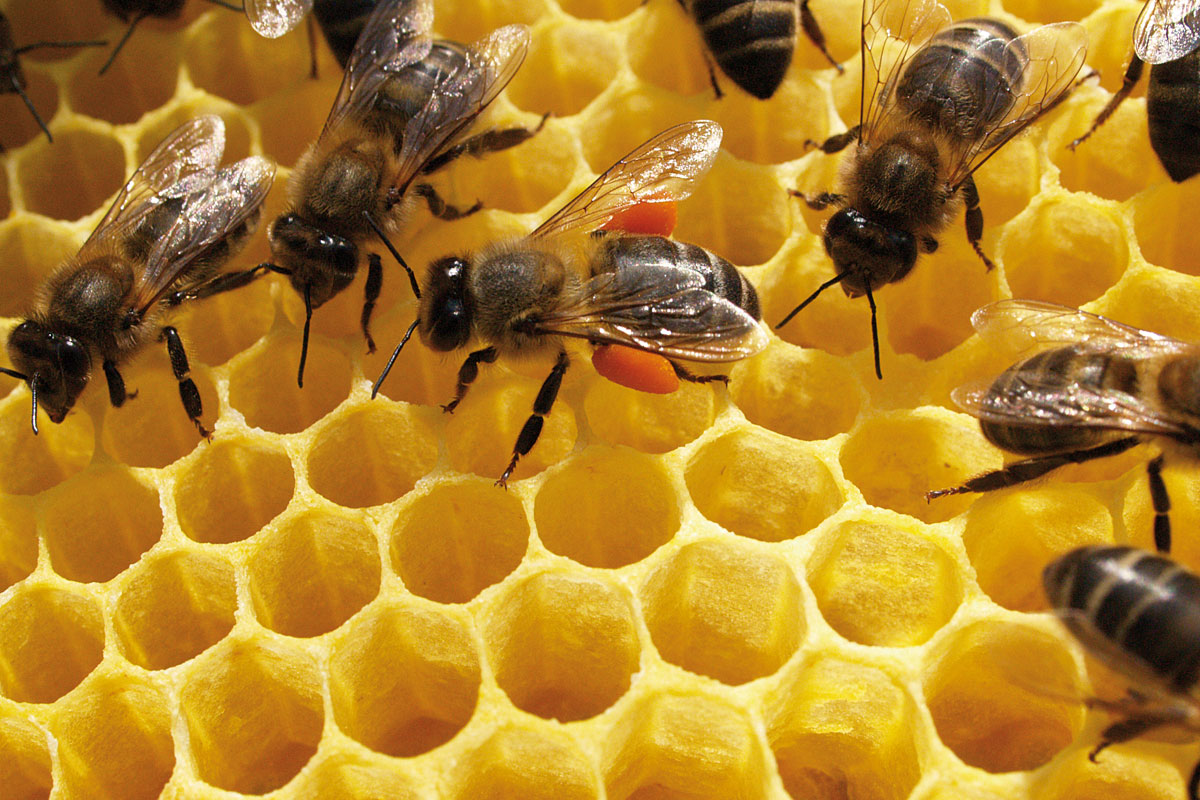
This topic has been around in the press for some time now. Indeed, it is very likely that some of you have read headlines like these: «An unknown disease attacks honeybees»; «Syndrome kills honeybees by the thousands»; «Fruit blossom pollination endangered as bees vanish»… Well, even though we can dispense with a certain amount of sensationalism, we have to admit that these are bad times for the honeybee (Apis mellifera). Wild colonies are virtually extinct in developed countries and bees in hives are dying by the thousands, often for reasons as yet unknown. What is really worrying about this situation is that it is affecting beekeeping worldwide. Researchers and apiculture technicians alike face a very complex problem.
«Wild colonies are virtually extinct in developed countries and bees in hives are dying by the thousands, oftem for reasons as yet unknow»
Disturbingly, the annual mortality of bee colonies exceeds the springtime population replacement rate and thus numbers have dwindled in recent years in most northern hemisphere countries. In many cases, the effects of the mite Varroa destructor are evident, a serious parasite widespread the world over, and responsible for the greatest health crisis affecting beekeeping. But a significant proportion of these colonies present different symptoms, of which the most surprising has been a sudden and severe loss of bees in just three or four weeks, causing colony collapse and reaching an insurmountable situation with just a few young bees and the queen left. This scenario fits the description of the so-called colony collapse or depopulation syndrome.
The symptoms of this syndrome fit perfectly with those described by J. Ellis, a honeybee researcher in the U.S.A., when referring the state of collapsed hives during the autumn of 2006. According to Ellis, these colonies were characterized by the presence of a few young bees and the queen left on deserted honeycombs, and in severe cases, a complete absence of adult bees, with few or no dead bees in the vicinity of the hive entrance or apiary. Also common in these colonies is the presence of some leftover capped brood cells (pupal stage of bee development), along with some beebread and honey on the combs, provided it has not been stolen by neighbouring bees or maybe attacked by wax moths.
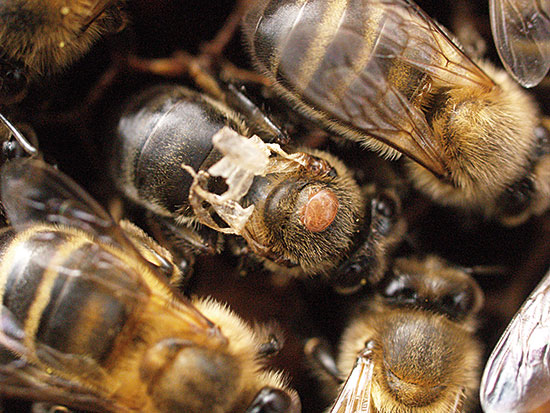
Bee in the pupal stage affected by the deformed wing virus, one of the viruses transmitted by the parasitic mite Varroa destructor. On its thorax there is an immature female of this honeybee parasite. This mite is responsible for the greatest health crisis in apiculture.
© E. Simó
Beekeepers and researchers, while admitting they are somewhat baffled and unable to find a specific cause of the disorder or syndrome, recognize that episodes with very similar symptoms have been recorded in the past, albeit not so persistent and widespread as they are at present. Manuals on bee diseases list, among other ailments, the: «Isle of Wight disease» in the early twentieth century; «spring and fall dwindling»; «May disease» and «autumn collapse». These so-called «disappearing diseases» described the sudden and severe loss of bees, which could even cause the collapse of the colonies.
Needless to say, in the past few years beekeepers have been suffering growing anxiety and helplessness as they watch their hives dwindle alarmingly. As a beekeeper myself, it is hard not to express my passion for bees, but I shall try to give my version as an apiculture technician, my job for several years at the Agrupación de Defensa Sanitaria Apícola (Beekeeping Health Protection Association, APIADS), which represents about 90,000 hives belonging to some 350 beekeepers in Valencia.
Recent events
In the late nineties, there was word in France of a problem related to bees vanishing from sunflower fields. Where, years before, beekeepers used to have well-stocked hives and good honey production, they were suffering depopulation and in a just a short time apiaries were almost unfeasible due to the lack of bees. Bees disappeared from the fields, with the same thing happening again in subsequent years. Yields dwindled alarmingly while mortality of the colonies grew each winter. First the French beekeepers and then researchers pointed to the effects of an insecticide recently used on sunflower crops, imidacloprid, a synthetic derivative of nicotine, which is highly toxic to bees.
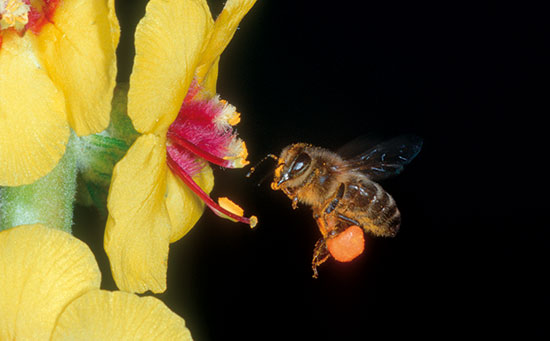
There is increasing alarm about the disappearance of honeybees, both in Europe and the U.S.A. Wild bee colonies have become virtually extinct in developed countries, and researchers and apiculture technicians are trying to solve a complex problem. In the picture, a honeybee collecting pollen from a Dark Mullein (Verbascum nigrum) flower.
© E. Simó
The past decade has been witness to other cases with similar symptoms. Many of the lost colonies have suffered a sudden disappearance of bees, the so-called depopulation syndrome or collapse disorder. The last five years have been particularly bad and winter mortality is steadily on the rise in the United States, United Kingdom, France, Germany and other European countries.
Spain suffered an outbreak of this syndrome during the winters of 2004 and 2005, coinciding with a severe drought. Thousands and thousands of colonies died, mostly during the autumn, with greater intensity in inland areas, showing a clear influence of colder climates. The status of many of these colonies coincided with the findings described earlier as depopulation syndrome. Beekeepers making regular visits to apiaries in the fall of 2004 were shocked by this dismal situation, watching on hopelessly as they lost between 40 and 50% of their hives, or in severe cases up to 80 or 90%, in just a few weeks.
LIKELY CAUSES
Professor emeritus at the U.S.A. University of Oregon, M. Burgett has extensive beekeeping experience and has taken an interest in this problem. He recognises that the most honest position is to accept that we are up against a very worrying increase in beehive mortality everywhere and researchers generally agree that it is a multifactorial problem. But while this approach helps address the problem, the situation is very distressing for beekeepers, who watch their hives disappearing year after year.
«Spain suffered an outbreak of this depopulation syndrome during the winters of 2004 and 2005, mostly during the autumn, with greater intensity in inland areas, showing a clear influence of colder climates»
Annual mortality in apiaries ranged from 5 to 10% before varroosis appeared, later it went up to 10 and 20% due to the parasite. According to more recent data available from several European countries and the U.S.A., these values had increased to 30-40% by 2007-2008. Beekeepers cannot endure these levels as they can hardly recover such losses by the division of colonies in spring.
Despite the appearance of the depopulation syndrome, one thing that’s clear is that varroosis is beekeepers’ main concern. A considerable part of current beehive mortality is directly or indirectly due to this parasitic mite, which we talked about previously in a special issue entitled Las abejas de miel (Honeybees, Mètode 33). Varroosis has troubled beekeeping the world over for the last forty years, requiring beekeepers’ to keep a constant lookout and monitor hives regularly to maintain it below the damage threshold. These parasites feed on the hemolymph of pupae and adult bees and undermine their vigour and immune system. In the first instance, affected colonies suffer from a chronic loss of bees, viral infections and other secondary infections that, in just over a year, kill the entire hive if the parasite population is left unchecked. One should also mention the impact on bees of the acaricide treatments used by beekeepers to limit the damage caused by this parasite.
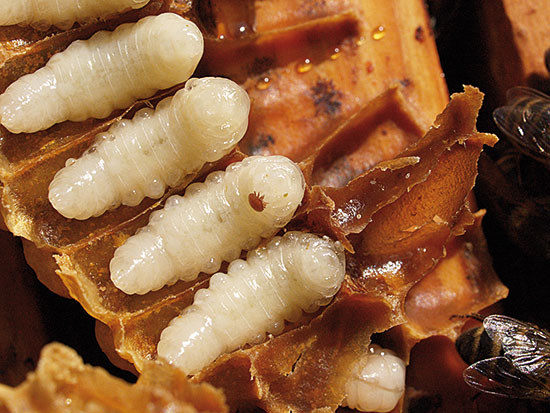
Pre-pupae of worker bees exposed to Varroa to see whether they are parasitized. One of them is below a reproductive female mite.
© E. Simó
Before the arrival of the Varroa mite, very little was heard about the effects of viral infections on honeybees. Most went unnoticed and were unknown outside scientific circles. Now we know that the mite transmits viruses, including the deformed wing virus, the paralysis virus, Kashmir bee virus and maybe others as yet unknown. Thus, viral infections are also considered by researchers as another key factor in bees’ fragile state of health, whether they are related to Varroa or not, as they are considered opportunists, taking advantage of their weakened state.
We can illustrate this point by recalling what B. V. Baile and L. Bailey, British researchers specializing in bee viruses, wrote in their book on Honey Bee Pests. On referring to the effects of a serious infection of the chronic paralysis virus, they state that the worst-hit colonies suddenly collapse, usually toward the end of summer, leaving only a few bees in the abandoned hives. Curiously, this scenario clearly reminds us of the effects of the colony depopulation syndrome that is being endured repeatedly and is widespread in many countries at present. In a recent survey carried out in the U.S.A. of bee pathogens isolated from colonies affected by the depopulation syndrome or collapse disorder, the most commonly found is the recently introduced virus known as the Acute Bee Paralysis Virus (ABPV) and the protozoan Nosema, an intestinal pathogen. Nonetheless, even the researchers behind this study did not dare to say that these pathogens are responsible. In fact they tend to be found in the depopulated colonies at the end of a process, which may have started weeks or months before due to debilitation caused by other reasons.
«The disappearance of bees could lead to a progressive loss of biodiversity due to the collapse of a pillar upon which ecosystems rest: the pollination of flowering plants»
Other important players are the aforementioned neonicotinoid pesticides. Applied to fruit-trees, corn, sunflower and rapeseed, either directly or systemically, their use is fairly widespread in agricultural environments. There have been serious episodes of poisoned hives and sudden loss of bees in the countryside where these pesticides are clearly directly responsible. It is of grave concern that in recent years the best-selling insecticide in the world is imidacloprid, the very insecticide that started the problem in sunflower fields in France. Detailed analyses have revealed sublethal doses to the bees in various parts of plants, including the nectar and pollen. Disorientation and loss of the sense of smell may lie behind the loss of field bees, and it can also lead to decreased cleaning behaviour inside the colony and problems of fungal infections. Neonicotinoids such as clothianidin and thiamethoxam are also at the root of very serious poisonings in which dead bees appear in the hive entrance. Nowadays, the use of these products has been banned in certain apiculture-related crops in France, Germany and Italy, while other countries like the United Kingdom have also considered this a prudent measure given the serious apicultural crisis and the decline in pollinators in general.
«It is of grave concern that in recent years the best-selling insecticide in the world is imidacloprid, the very insecticide that started the problem in sunflower fields in France»
On a regional level, we can add the effects of other factors such as the lack of biodiversity in the pollen collected by bees. The increase in agricultural monocultures and urban encroachment, as well as the effects of global warming on flowering, can all reduce pollen supply and variety at an alarming rate, and nutritional deficiencies can have more or less serious consequences by weakening bees’ vigour and, thus, their resistance to disease.
IMMEDIATE IMPACT
The decline in hives in the U.S.A. during the second half of the twentieth century can serve as a paradigm of what is happening worldwide in beekeeping based on the Western honeybee Apis mellifera. There was a steady decline in the number of beehives in the sixties and seventies, coinciding with serious bee poisoning episodes during the agrochemical boom, while the eighties and nineties were witness to the consequences of varroosis, and the last ten years have been branded by all the factors discussed so far.
But besides the direct economic effects for professional beekeepers and honey production, all international agencies involved in assessing the scope of this global bee crisis highlight the huge impact it will have due to insufficient pollination of a large number of crops that are vital for human and animal food supply. According to the FAO (Food and Agriculture Organisation of the United Nation), pollination by honeybees has an economic value thirty or forty times that of products derived from beekeeping. Not to mention the social and environmental benefits that bees provide in areas of natural flora, which are difficult to estimate but certainly of considerable value.
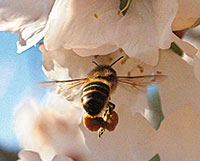
A bee collecting pollen from almond blossom. It is estimated that 90% of almond production depends on insect pollination. A decline in bee populations would reduce the production of fruits and seeds.
© E. Simó
This is the crux of the matter. Honeybees perform about 80% of the total pollination of entomophilous plants. In agricultural habitats, bees can represent up to 95% of insect pollinators. If we consider that not only bees are suffering a population decline, but also other pollinators such as bumblebees, solitary bees and butterflies have been on the decline over the past twenty years, we can get an idea of the true immensity of the problem. Consequences include a chronic decline in fruit and seed production, both cultivated and wild, and a progressive loss of biodiversity due to the collapse of a pillar upon which ecosystems rest: the pollination of flowering plants.
The European Parliament has taken up the concerns of European beekeepers and has proven sensitive to the already widespread impact of pollinator decline on agricultural environments. A draft resolution urges the Commission to make a concerted effort to investigate the parasites and other diseases responsible for ever growing beehive mortality. This problem has even found voice in the United States Congress, where there is growing alarm over the lack of bees, without which –to give an example– California almonds would cease to exist.





